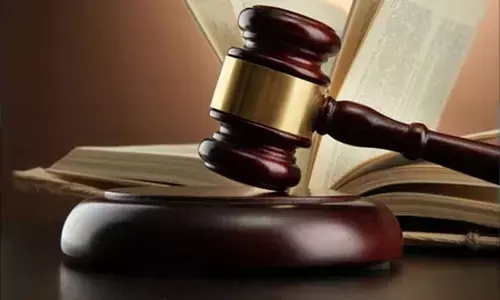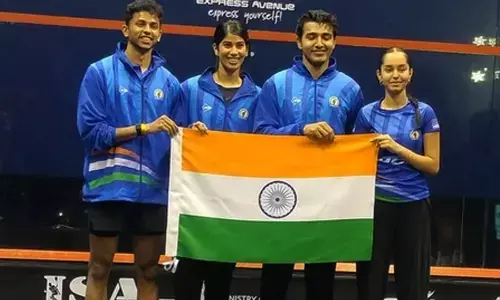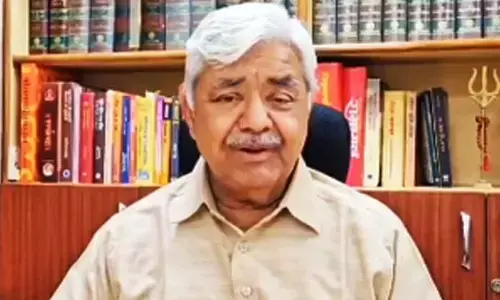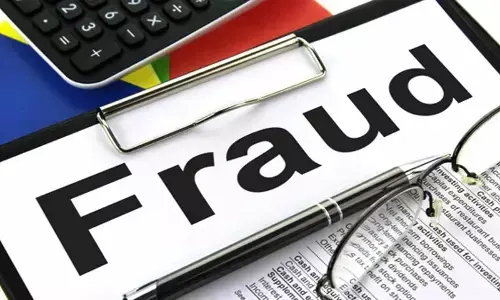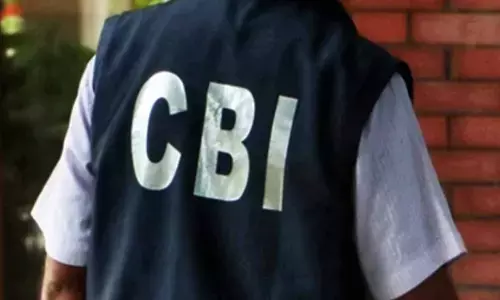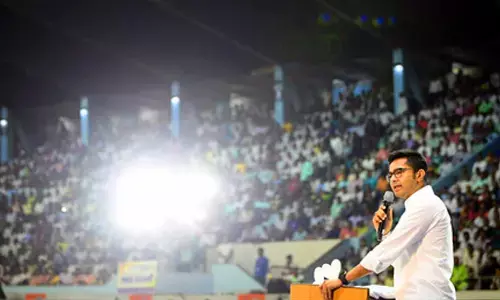Modi, KCR—Popular waves!
Narendra Modi, KCR—Popular Waves. Self-confidence is the main strength for a fighter. Besides believing in oneself, the main input required is hard work. Being personification of self-confidence, K Chandrasekhara Rao (KCR) put up a lot of hard work undertaking whirlwind tour and addressing ten meetings a day for a number of days.
Self-confidence is the main strength for a fighter. Besides believing in oneself, the main input required is hard work. Being personification of self-confidence, K Chandrasekhara Rao (KCR) put up a lot of hard work undertaking whirlwind tour and addressing ten meetings a day for a number of days.
The trend visible in the polling in Telangana on Wednesday appears to be favouring Telangana Rashtra Samiti (TRS) followed, of course, by the Congress. How close second the Congress would be is only to be guessed till May 16. There was a kind of wave in north Telangana, save Khammam district that is expected to bring rich dividends to TRS.

Self-confidence is the main strength for a fighter. Besides believing in oneself, the main input required is hard work. Being personification of self-confidence, K Chandrasekhara Rao (KCR) put up a lot of hard work undertaking whirlwind tour and addressing ten meetings a day for a number of days. He was the only campaigner for his party. He had clarity of purpose in thought, word and action. Luckily for him, the party that was supposed to reap the fruits of the decision to bifurcate Andhra Pradesh and help the people of Telangana realise their dream of separate statehood, the Congress, had helped KCR by all means.
Right from July 30, 2013 when the decision to bifurcate the State was taken by the Congress Working Committee, the ruling party at the Centre was bent on committing hara-kiri. It allowed Chief Minister Kiran Kumar Reddy to go on talking against its decision holding media conferences at his office and official residence. It did not act on the Bill till December. The Congress party is known for its extraordinary power to snub chief ministers, sack them at will or force them to fall in line. The way Indira Gandhi made Chief Minister Kasu Brahmanada Reddy, who told her very confidently that he enjoys absolute majority in the Assembly, to yield and submit his resignation within minutes is part of the folklore. PV Narasimha Rao was allowed to expand his Cabinet and after a week he was summarily sacked and President’s Rule was imposed at the height of Jai Andhra agitation in 1972. PV, too, had majority in the House. Kiran Kumar Reddy, on the other hand, had no majority in the House. Half of the Cabinet was not with him. Most of the ministers were not on talking terms with their CM. He was not only allowed to wage a virtual war of arguments week after week, he was also allowed to clear important files. Top leaders of the Congress party confide in private that Kiran Reddy made a fortune in his tenure and the party high command expected him to spend during elections in both Telangana and Seemandhra. Sensing this, Kiran Reddy smartly left the party to float his own nondescript outfit and pretend to be in the contest spending far less than what he would have been forced to had he remained loyal to the party high command. At least that is what an important leader from Delhi said.
The second critical mistake was appointment of Ponnala Laxmaiah as Telangana Pradesh Congress President. This decision antagonised the most powerful community in the Congress and the region and leaders of that community were not able to reconcile with the party’s decision. They did not cooperate with the TPCC president. Laxmaiah, a highly educated Backward Class leader, does not represent Telangana sentiment. Nor does he command personal loyalty of the Congress leaders in Telangana region. Like Chinese warlords, the Congress leaders in Telangana, who are strong in their own fiefdoms, could not put up a united front to lead the campaign. In fact, there was no Congress campaign worth the name across the region with a single command or a joint command. The Congress and the TRS are the only parties with strong theme. The better fighter among them would win the crown. You can imagine who the winner would be. Your guess is as good as mine. Telugu Desam Party (TDP) has got a confident and hard working leader but people of Telangana region have not been able to identify themselves with the TDP for obvious reasons. BJP has neutralised its advantage in Telangana by going for a tie-up with the TDP for the sake of having Naidu back in the NDA as part of a valid national strategy. The moot question is which party among the Congress and TRS would emerge number one and form the government and whether it will be a single-party government or a coalition one. If it is coalition government, will the MIM be part of the arrangement? Whichever party stands in the first place, I presume it will be TRS, the gap between the first and second positions would not be very wide. This presumption is based on the information given by the HMTV reporters in all the district headquarters and a number of independent observers who are known to be unbiased. It should be taken with the caveat.
While the TRS appears to have picked up in the last lap, the BJP on the national scene seems to have lost a bit of the momentum thanks to the unseemly controversy raked up by careless comments by persons like Baba Ramdev. In fact, whatever attributes we discussed in case of KCR are more than there for Modi. He was so confident of himself bordering arrogance. He addressed more than hundred meetings literally from Jammu to Kanyakumari. Omar Abdullah had taunted Modi to visit Kashmir if he can. But for Kashmir, Modi visited every part of India, including northeastern States. Undoubtedly, Modi created a wave. My own doubt, in spite of opinion polls by all the English channels and some newspapers, is whether the velocity of the wave would be enough to elevate Modi and put him in PM’s chair. Take, for instance, the constituencies in UP and Bihar, two States where the BJP is hoping to make maximum gains. Polling for 14 seats in UP and seven in Bihar took place on Wednesday. Sonia Gandhi, Rajnath Singh, Sharad Yadav and many other stalwarts are in the fray. Out of the 14 seats that went to polls in UP in the seventh phase, only two seats were won by the BJP in 1999 and 2004 and only one (Lucknow-Laljit Tandon) in 2009. It finished second in Kanpur in the last election and in the remaining 12 constituencies the BJP got just 10.67 per cent of vote share. In 11 of them the party candidates lost deposit. In Rae Bareili, where Sonia won, the BJP was relegated to third position by the BSP, although both the parties could not save deposit. Except in Lucknow, the party was in fourth place in eight constituencies and third in four and second in one constituency. The difference between the percentage of votes polled by BJP candidates in the 12 seats (except Lucknow and Kanpur) was a whopping 24.64 per cent. That means the BJP has to improve its performance by three times (from its 2009 average vote share of 13.54 per cent to 38.18) if it has to win. This kind of long jump can be expected only when there is a sympathy wave such as the one in 1984 in the wake of Indira Gandhi’s assassination. In a State like UP which is fragmented on caste and community lines, a leap by three times is most unlikely. The Congress won, surprisingly, six out of the14 seats in 2009. While the BJP’s average (including Lucknow and Kanpur) was 14.36, the average secured by Bahujan Samaj Party (BSP) was 25.24. It is extremely difficult to take away major chunk of votes from BSP and Samajvadi Party (SP). Hence the chances of BJP bagging a majority of the 14 seats are extremely low. These seats are between Lucknow and Gorakhpur.
In north-central Bihar, there was polling on Wednesday in seven constituencies. The BJP’s position in Bihar in 2009 was far better than what it was in UP. Forgetting 2004 when the people across the country decided to punish NDA, the BJP in Bihar contested 15 seats in 1999 and 2009 and won 12 of them both the times. In last elections the BJP-JD (U) combine had swept the seven seats that went to polls yesterday and the JD (U) had won five of them. But the BJP’s good performance was largely due to its stable alliance with the JD (U). The 17 years alliance was broken by Chief Minister Nitish Kumar when the BJP anointed Narendra Modi as prime ministerial candidate. Now neither the JD (U) nor the BJP is in a position to repeat the past performance. In 2009 when there was no tie-up between the RJD and the Congress, the combined vote share of these two parties was 47.72 (RJD-27.7 and Congress-20.02) in these seven constituencies while the combined vote for BJP-JD(U) combine was 29.48. While the BJP and JD (U) have fallen apart, the RJD and the Congress came together this time. Lok Janshakti Party of Ramvilas Paswan which is in alliance with the BJP is strong only in one of the seven constituencies. It is difficult for the BJP to do as well as it did in 2009 even after factoring Modi wave. Pollsters and journalists agree that desire for change is sweeping the land. But hard-headed calculations and realistic appraisal would leave one in doubt about Modi (BJP) getting more than 200 seats. Modi peaked perhaps too early and nothing spectacular could be expected between now and May 12 when the last phase of polling would take place.










